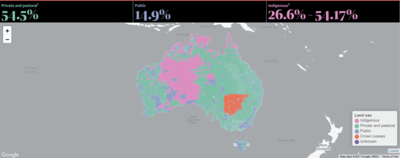Gina does.
And she's buying more.
(but selling off the cattle stations)
From the Guardian Australia via Farmlandgrab, May 16
Who owns the Australian outback is a vexed question. The true answer is First Nations peoples, whose ownership stems back 60,000 years. The legal answer is more complex. It’s a mess of titles – freehold, pastoral leases, crown leases, public land, native title and land held by Aboriginal trusts.And no two jurisdictions store or share that data in the same way.

Visit the interactive map here
Six months ago Guardian Australia set out to learn who owns the outback. The data we received was unwieldy, incomplete, inconsistent and often came with a hefty price tag. There is no nationally consistent protocol for recording land tenure and land use information, or even clearly established definitions of what constitutes ownership or control of land.So, in the absence of official data, we have collated large datasets from every state and territory and pieced together a database of land ownership. We then looked to the work of a rural newspaper, the Weekly Times, which has been tracking farm ownership. We also looked at information contained in media reports, official websites of known major landowners, cattle brand directories, government servers and other online maps.The information we have sourced paints a picture of increasingly consolidated land ownership in outback Australia and a growing Indigenous estate.
What the data shows
Pastoral leases cover 44% of Australia, according to Austrade. Pastoral leases are defined by Austrade as a title issued for the lease of an area of crown land to use for the limited purpose of grazing of stock and associated activities. We were able to identify the leaseholders for just over half that area, pulling together data on more than 400 owners who together hold 700 stations covering 189.5m hectares – or about a quarter of the country.The person who holds the most land in this pastoral-lease data, by far, is the Western Australian mining magnate Gina Rinehart, who controls 9.2m hectares, or 1.2% of Australia’s landmass, through three different corporate entities.The biggest corporate landholder is the ASX-listed Australian Agricultural Company. AACo’s biggest shareholder is the Bahamas-based AA Trust, controlled by the British billionaire Joe Lewis, who is also the owner of the UK football team Tottenham Hotspur.About 40% of Australia is covered by native title, in both exclusive and shared title. Australian government reports state that Indigenous communities hold the freehold title to 17% of the country, mainly in the Northern Territory and South Australia.Guardian Australia’s definition of Indigenous tenure, for mapping purposes, includes exclusive-possession native title and freehold, which confer the right to exclude others from the land. This amounts to about 26% of Australia’s landmass. This definition does not invalidate non-exclusive native title – land that features other forms of ownership such as pastoral stations – or Indigenous ownership in areas where native title has been extinguished. When non-exclusive native title is included, the proportion of Australia is about 54%.Keven Smith, a Torres Strait man and chief executive of Queensland South Native Title Services, says the connection of traditional owners to a place is not defined by whether they are able to be granted native title.“If you ask the question of who owns Australia, I would say that First Nations people own this country,” Smith says. “Even though there’s limited application of native title over the four corners of this nation, cultural heritage is tenure-blind.”....
....MUCH MORE
The Australian Financial Review says Ms Rinehart is the wealthiest person in Australia. (Mumbrella, May 27)